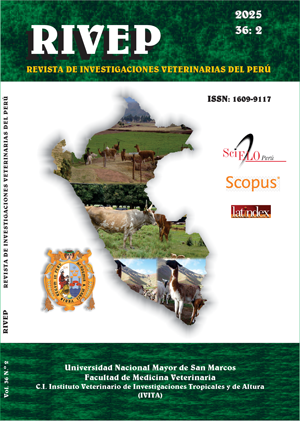Implications of the individual variation in animal personality on the welfare of Oreocrhomis niloticus
DOI:
https://doi.org/10.15381/rivep.v36i2.28555Keywords:
behavior, consistency, fish, profitability, sustainabilityAbstract
The aim of the study was to evaluate the effect of variation in animal personality on behavioural indicators, stress and productive performance of Oreochromis niloticus. Twenty-four fish with similar weight and total length were used and distributed according to their personality phenotype in two treatments: Proactive (P; n=12); Reactive (R; n=12). Behaviour was assessed by latency to resume feeding after a stressful situation. This was done immediately after taking weight and total length measurements every 15 days until completing five moments. In addition, at the end of the study, ventilatory frequency, blood glucose levels and weight gain were determined. The analysis was performed using general linear models and non-parametric tests. The latency to resume feeding was different between treatments (p>0.05). P were habituated in 92 and 58% of these reduced their responses over time (p<0.05). R fish were habituated in 75 and 33% reduced their responses over time (p<0.05). P fish showed lower basal glucose levels than R (p<0.05). Ventilatory frequency did not differ between treatments (p>0.05). At the end of the study, P fish had greater weight gain than R (p<0.05). It is concluded that P fish resumed feeding faster, had better physiological and productive performance indicators. In addition, a higher percentage of P consistently reduced their latencies to feed over time.
Downloads
Downloads
Published
Issue
Section
License
Copyright (c) 2025 Alex Ríos-Moreno, Joseph Grajales-Cedeño, Richard Mudarra, Reynaldo Vargas

This work is licensed under a Creative Commons Attribution 4.0 International License.
AUTHORS RETAIN THEIR RIGHTS:
a. Authors retain their trade mark rights and patent, and also on any process or procedure described in the article.
b. Authors retain their right to share, copy, distribute, perform and publicly communicate their article (eg, to place their article in an institutional repository or publish it in a book), with an acknowledgment of its initial publication in the Revista de Investigaciones Veterinarias del Perú (RIVEP).
c. Authors retain theirs right to make a subsequent publication of their work, to use the article or any part thereof (eg a compilation of his papers, lecture notes, thesis, or a book), always indicating the source of publication (the originator of the work, journal, volume, number and date).



